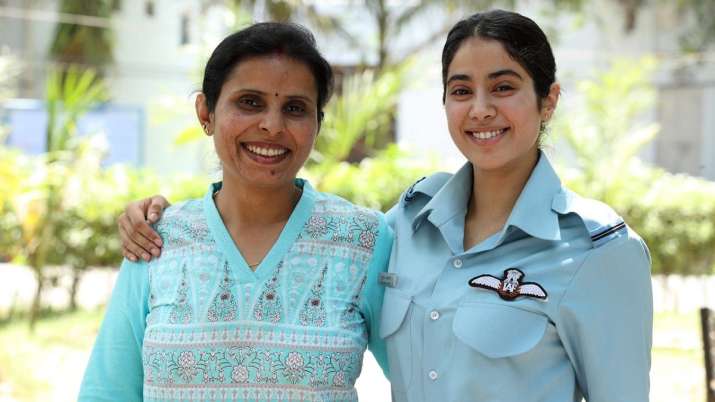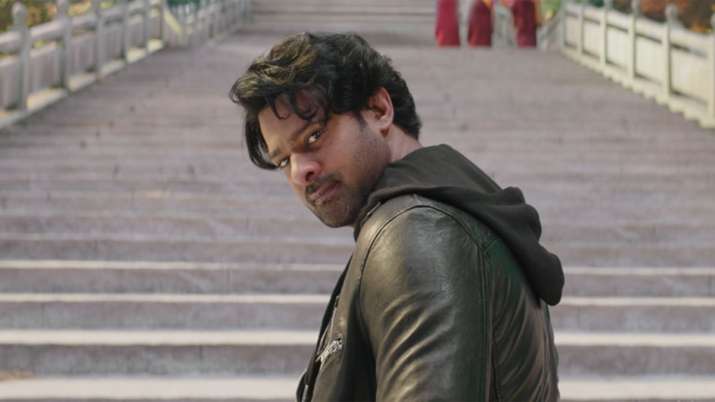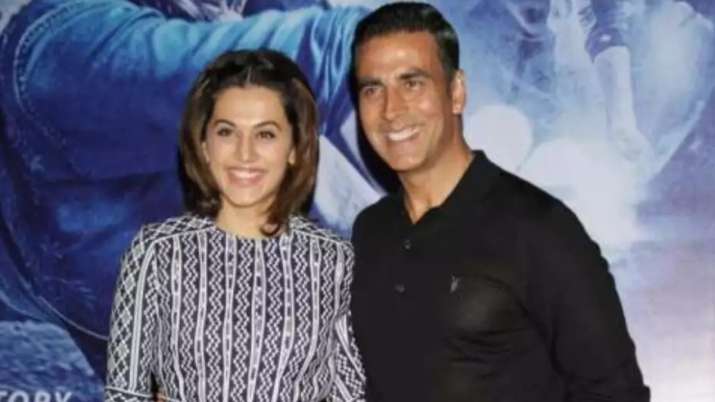 Exposure to the ultraviolet (UV) rays, which most often comes from the sun, can cause skin cancer in athletes, according to a new study.
Exposure to the ultraviolet (UV) rays, which most often comes from the sun, can cause skin cancer in athletes, according to a new study.from Top Lifestyle News- News18.com https://ift.tt/2Lgj24e
 Exposure to the ultraviolet (UV) rays, which most often comes from the sun, can cause skin cancer in athletes, according to a new study.
Exposure to the ultraviolet (UV) rays, which most often comes from the sun, can cause skin cancer in athletes, according to a new study.Last month, a class-action suit was filed in the US District Court for the Northern District of California against Apple and Samsung owing to their smartphones emitting harmful radiations. The suit claimed that "the RF (Radio Frequency) radiation emitted from smartphone devices designed and manufactured by Apple and Samsung exceed legal limits set forth by the Federal Communications Commission (FCC)".
However, now, countering that claim, a study published in the New Zealand Medical Journal notes that any potentially harmful biological effects are more commonly seen in low-quality scientific studies, CNet reports.
The researchers argue that many of the studies indicating the effect of radiofrequency (RF) radiation going beyond heating of human tissue are of low quality but get published because they are interesting.
They further argue that these studies lack the consistency in terms of their result and anti-5G sentiment without scientific evidence would do more harm than good.
Earlier this week, Chicago Tribune did a study and found that iPhone 7, iPhone 8, iPhone X, and Samsung's Galaxy S8, Galaxy S9, and Galaxy J3 emit radiation that exceeded the set limits mentioned by FCC.
Talking about the harmful effects of these radiations, the lawsuit claimed that it can cause increased cancer risk, cellular stress, increase in harmful Free Radicals, genetic damages, structural and functional changes of the reproductive system, learning and memory deficits, neurological disorders, and negative impacts on general well-being in humans.
As Apple and Samsung had said in response, the new study by researchers in New Zealand Journal also suggests inaccuracy in testing.
With inputs from ANI.
 After the majestic Baahubali 2, Prabhas is impressing fans with his latest action-drama Saaho at the box office. The Sujeeth directed film, which also stars Shraddha Kapoor in the lead role, opened to Rs 24.40 crore on its opening day. The Hindi version of the film witnessed more or less a similar fate on its first Saturday earning Rs 23 crore, taking the latest Saaho box office collection to Rs 47.40 crore, according to Box Office India. This means that Prabhas starrer Saaho is all set to cross the Rs 50 crore mark on Sunday.
After the majestic Baahubali 2, Prabhas is impressing fans with his latest action-drama Saaho at the box office. The Sujeeth directed film, which also stars Shraddha Kapoor in the lead role, opened to Rs 24.40 crore on its opening day. The Hindi version of the film witnessed more or less a similar fate on its first Saturday earning Rs 23 crore, taking the latest Saaho box office collection to Rs 47.40 crore, according to Box Office India. This means that Prabhas starrer Saaho is all set to cross the Rs 50 crore mark on Sunday.Chandrayaan 2, India's second moon mission, is expected to complete its final orbit-lowering manoeuvre around the moon this evening. The lunar-bound manoeuvre is planned for 6-7 pm on 1 September by firing the spacecraft's onboard propulsion system. This fourth and final manoeuvre will move Chandrayaan 2 from its current 126 x 168 km (nearest x farthest distance) elliptical orbit to an almost-circular orbit of 114 x 128 km.
The Chandrayaan 2 composite has carried out three successful in-orbit manoeuvres since it entered lunar orbit — all to lower its altitude for separation of the Vikram lander and the landing itself. If successful, the final manoeuvre today will put the spacecraft on a circular path that passes over the lunar poles at a distance of roughly 100 km from the surface. Entering this circular orbit is the mission's final milestone before the Vikram lander separates from the orbiter to make its planned soft-landing on the moon's surface on 7 September at 1.55 am IST.

Chandrayaan 2 composite orbiting the moon before the lander's separation. Image: ISRO
The 100 x 100 km circular orbit will be close enough for the Vikram lander, currently bound to the orbiter in a 'composite', to separate. The separation and landing sequences are planned for 2 September and 7 September at 1.40 am, respectively. Between these two key milestones, the first maps of the landing site will be created (planned for 3 and 4 September) by the Vikram lander to ensure the landing site is safe, as previously thought, to make a soft-landing.
This is a crucial step in the mission since ISRO's mission engineers won't be operating the spacecraft remotely from the control centre. The orbiter will also be surveilling its year-long home for the first time, ensuring that no damage was caused to its instruments on the journey so far and conducting a thorough examination of the Vikram lander's landing site at the moon's South Polar region.
Chandrayaan 2 is expected to make its long-awaited powered descent and landing on 7 September at 1.40 am IST in a landing sequence that the ISRO Chief describes as '15 minutes of terror'.
While subsequent events in the mission won't be streamed live, you can catch live updates on the mission on our dedicated Chandrayaan 2 domain, our Twitter page, ISRO's website, or Twitter page.
In compliance with the advisory issued by the Directorate General of Civil Aviation (DGCA), national carrier Air India on Saturday requested passengers not to carry "15-inch Apple Mac Book Pro (purchased between September 2015 - February 2017) as checked-in or hand baggage."
Issuing a public note on Twitter, Air India said, "In view of the advisory by DGCA regarding the transportation of affected lithium batteries by Air, we request our Passengers not to carry 15-inch Apple Mac Book Pro (purchased between September 2015 - February 2017) as checked-in or hand baggage."
The DGCA had on 26 August asked passengers not to fly with older generation 15-inch MacBook Pro units which have been recalled by Apple, as they may pose a safety risk.
#FlyAI : In view of the advisory by DGCA regarding transportation of affected lithium batteries by Air, we request our Passengers not to carry 15-inch Apple Mac Book Pro (purchased between Sep 2015 – Feb 2017) as checked-in or hand baggage. pic.twitter.com/K0hCxlR43h
— Air India (@airindiain) August 31, 2019
"Consequent upon the recall of a limited number of older generation 15-inch MacBook Pro laptops by Apple Inc. (sold primarily between September 2015 and February 2017) due to fears that their batteries may overheat and pose a safety risk," the advisory stated.
Earlier on 20 June, Apple had announced a voluntary recall of the older generation 15-inch MacBook Pro units which contained a battery that may overheat and pose a fire safety risk.
The Federal Aviation Administration (FAA) which has the power to regulate all civil aviation matters in the United States of America had banned all passengers from carrying the model on flights.
 TV and film actor Ram Kapoor's weight loss has been one of the most shocking and inspiring stories of 2019. Ram Kapoor made made his TV debut with Nyaay in 1997 and is best known for TV serials such as Kasamh Se, Bade Acche Lagte Hain and many more. The actor has also been a part of films such as Monsoon Wedding, Hazaaron Khwaishein Aisi, Golmaal Returns, Agent Vinod, Student Of The Year, Baar Baar Dekho and so on. Along with his impressive acting that touched a chord with the audience, Ram also made news for putting on a lot of weight. However, this year fans were in for a sweet and incredible surprise as Ram Kapoor lost oodles of weight and stunned us all with his new avatar.
TV and film actor Ram Kapoor's weight loss has been one of the most shocking and inspiring stories of 2019. Ram Kapoor made made his TV debut with Nyaay in 1997 and is best known for TV serials such as Kasamh Se, Bade Acche Lagte Hain and many more. The actor has also been a part of films such as Monsoon Wedding, Hazaaron Khwaishein Aisi, Golmaal Returns, Agent Vinod, Student Of The Year, Baar Baar Dekho and so on. Along with his impressive acting that touched a chord with the audience, Ram also made news for putting on a lot of weight. However, this year fans were in for a sweet and incredible surprise as Ram Kapoor lost oodles of weight and stunned us all with his new avatar. Salman Khan as the supercool host of Bigg Boss 13 is back with a bang in a new promo. Right from flirting with Surbhi Jyoti to revealing new twists in the new season, Salman Khan promises that BB 13 is going to be a roller coaster ride filled with love, fights and controversies. The Bharat actor has been the host for several seasons. Besides the superstar, Amitabh Bachchan, Shilpa Shetty and Arshad Warsi have also been the show’s hosts.
Salman Khan as the supercool host of Bigg Boss 13 is back with a bang in a new promo. Right from flirting with Surbhi Jyoti to revealing new twists in the new season, Salman Khan promises that BB 13 is going to be a roller coaster ride filled with love, fights and controversies. The Bharat actor has been the host for several seasons. Besides the superstar, Amitabh Bachchan, Shilpa Shetty and Arshad Warsi have also been the show’s hosts. About 60 years ago, she was born into a well-to-do family. Unfortunately, she got separated from her parents. Later, her marriage to a cook of late Bollywood star Feroz Khan took her from West Bengal to Mumbai. Then "cracks" in her family emerged and her struggle for livelihood increased.
About 60 years ago, she was born into a well-to-do family. Unfortunately, she got separated from her parents. Later, her marriage to a cook of late Bollywood star Feroz Khan took her from West Bengal to Mumbai. Then "cracks" in her family emerged and her struggle for livelihood increased. National-Award winning actor Rajkummar Rao turned a year older on August 31, and his girlfriend and actress Patralekhaa dropped a love post for him on social media. "Happy birthday, my most precious, my dearest Rajkummar. It's so difficult to translate my feelings into words especially on a platform like this. I wish nothing more for you, but, a life that is filled with peace, prosperity, learning and growth," Patralekhaa wrote on Instagram along with two photographs.
National-Award winning actor Rajkummar Rao turned a year older on August 31, and his girlfriend and actress Patralekhaa dropped a love post for him on social media. "Happy birthday, my most precious, my dearest Rajkummar. It's so difficult to translate my feelings into words especially on a platform like this. I wish nothing more for you, but, a life that is filled with peace, prosperity, learning and growth," Patralekhaa wrote on Instagram along with two photographs.There have been leaks flying about the OnePlus 7T and 7T Pro smartphones and rumour has it that the devices are going to be unveiled in India before the global markets. The most recent leaks are about the OnePlus 7T Pro and what the device is expected to come with.
Reputed tipster Ishan Agarwal, who has earlier been right about OnePlus leaks, has said that the 7T Pro will look exactly like the 7 Pro in terms of design and screen. However, the device will be packing in a Snapdragon 855 Plus chipset instead of the Snapdragon 855. The device is also said to come with Android 10 out-of-the-box.
The phone is also said to come with the Warp Charge 30T which could charge the device from 0-50 percent in about 20 minutes while a full charge from zero percent will take 65 minutes. Apart from that, the 7T Pro is said to have the same camera layout as the OnePlus 7 Pro however the device is going to come with Macro Mode, HEVC, and Hybrid Image Stabilisation.
Ishan Agarwal has previously tweeted out that OnePlus 7T (not the 7T Pro, mind you) will be coming with a 90 Hz refresh rate display with QHD+ resolution. We'll have to see how the leaks pan out when the devices are launched which is rumoured to be on 26 September.
 Actor Rajesh Khatter welcomed a baby boy with wife Vandana Sajnani on Janmashtami. The couple has been married for over 11 years now. The duo faced several obstacles before bringing this bundle of joy into their life. Sajnani went through three miscarriages, 3 failed IVFs, IUI and even faced failure at surrogacy. The couple named the boy after Lord Krishna. The Beyhadh actor has named him Vanraj Krishna.
Actor Rajesh Khatter welcomed a baby boy with wife Vandana Sajnani on Janmashtami. The couple has been married for over 11 years now. The duo faced several obstacles before bringing this bundle of joy into their life. Sajnani went through three miscarriages, 3 failed IVFs, IUI and even faced failure at surrogacy. The couple named the boy after Lord Krishna. The Beyhadh actor has named him Vanraj Krishna.US Citizenship and Immigration Services officers can now create fictitious social media accounts to monitor social media information on foreigners seeking visas, green cards and citizenship.
A Facebook panel is seen during the Cannes Lions International Festival of Creativity, in Cannes, France. Reuters
An updated Homeland Security Department review of potential privacy issues dated July 2019 that was posted online on Friday essentially reversed a prior ban on officers creating fake profiles.
A USCIS statement explaining the change says fake accounts and identities will make it easier for investigators to search for potential evidence of fraud or security concerns as they decide whether to allow someone entry into the US.
The change in policy was preceded by other steps taken by the State Department, which began requiring applicants for US visas to submit their social media usernames this past June, a vast expansion of the Trump administration's enhanced screening of potential immigrants and visitors.
It's unclear exactly how the creation of fake social media accounts would work given policies of platforms like Facebook and Twitter, which both specifically state that impersonation — pretending to be someone other than yourself — violates their terms of use.
Twitter and Facebook recently shut down numerous accounts believed to be operated by the Chinese government using their platforms under false identities for information operations.
"It is against our policies to use fake personae and to use Twitter data for persistent surveillance of individuals. We look forward to understanding USCIS's proposed practices to determine whether they are consistent with our terms of service," according to a Twitter statement. Facebook did not immediately provide comment.
Such a review of social media would be conducted by officers in the agency's Fraud Detection and National Security Directorate on cases flagged as requiring more investigation. The privacy assessment notes that officers can only review publicly available social media available to all users on the platform — they cannot "friend" or "follow" an individual — and must undergo annual training.
The officers are also not allowed to interact with users on the social media sites and can only passively review information, according to the DHS document.
While lots of social media activity can be viewed without an account, many platforms limit access without one.
Dave Maass, senior investigative researcher for the civil liberties advocacy group Electronic Frontier Foundation, said such use of fake accounts "undermines our trust in social media companies and our ability to communicate and organize and stay in touch with people."
He added: "It can't be this double standard where police can do it, but members of the general public can't."
Mike German, a retired FBI agent and a fellow in the Brennan Center for Justice's Liberty and National Security program said it's important for strong guidelines to be in place and for lawmakers to ask lots of questions to ensure there are no abuses.
"It's easy to conjure up a use where the use is appropriate and entirely necessary, but also where it could be abused," German said. "It should only be used in cases where absolutely necessary."
In January 2017, former Homeland Security Department Secretary Jeh Johnson issued a privacy impact update giving authority to USCIS to "conduct law enforcement activities including but not limited to accessing internet and publicly available social media content using a fictitious account or identity."
But a privacy impact assessment was required to be completed first.
Reached by phone on Friday, Johnson declined to comment.
Bipartisan support for additional background checks involving social media was initially spurred by the fallout of the 2015 San Bernardino attack, which resulted in 14 people's deaths.
In that case, the shooter Syed Rizwan Farook's wife Tashfeen Malik gained entry to the US on a fiancée visa — a process that did not involve a social media check.
The day after the attack, Facebook found a post on a page maintained by Malik pledging her and Farook's allegiance to the leader of the Islamic State group. The page was under an alias. Authorities have said Malik and Farook exchanged messages about jihad and martyrdom online before they were married and while she was living in Pakistan.
The two ultimately died in a gun battle with police.
 Superstar Salman Khan is these days busy in the shooting of his cop series Dabangg 3. The actor has been become quite active on social media ever since the release of his film Bharat and keeps on updating his fans with his pictures or videos. Yet again, the actor has caught everyone’s eyeballs through a video in which he can be seen hitting himself with a whip. He is seen chatting with members of a community and discussing their art and later takes the whip and performs the action.
Superstar Salman Khan is these days busy in the shooting of his cop series Dabangg 3. The actor has been become quite active on social media ever since the release of his film Bharat and keeps on updating his fans with his pictures or videos. Yet again, the actor has caught everyone’s eyeballs through a video in which he can be seen hitting himself with a whip. He is seen chatting with members of a community and discussing their art and later takes the whip and performs the action. Pregnant women are three times more likely to develop severe Malaria than non-pregnant women acquiring infections from the same area.
Pregnant women are three times more likely to develop severe Malaria than non-pregnant women acquiring infections from the same area. According to WHO, more than 7 million people are killed due to direct tobacco use every year while around 1.2 million die as a result of being exposed to second-hand smoke.
According to WHO, more than 7 million people are killed due to direct tobacco use every year while around 1.2 million die as a result of being exposed to second-hand smoke. Nora Fatehi moved from Canada to India a few years ago to become an actress in Bollywood. She even managed to bag a few acting projects initially, including "Roar: Tigers of the Sundarbans" and "Crazy Cukkad Family", but these were low-profile projects and she went unnoticed. Then, her appearance on "Bigg Boss" and the dance numbers "Manohari" in "Baahubali: The Beginning" changed the tide. People started noticing Nora, and soon she was belting out the hit dance numbers, "Dilbar" ("Satyamev Jayate") and "O saki saki" ("Batla House").
Nora Fatehi moved from Canada to India a few years ago to become an actress in Bollywood. She even managed to bag a few acting projects initially, including "Roar: Tigers of the Sundarbans" and "Crazy Cukkad Family", but these were low-profile projects and she went unnoticed. Then, her appearance on "Bigg Boss" and the dance numbers "Manohari" in "Baahubali: The Beginning" changed the tide. People started noticing Nora, and soon she was belting out the hit dance numbers, "Dilbar" ("Satyamev Jayate") and "O saki saki" ("Batla House"). After making her debut in the Bollywood industry through Dhadak, actress Janhvi Kapoor will next be seen in a uniformed avatar in the film Gunjan Saxena: The Kargil Girl, the posters of which were released by the makers a few days back. Now on the occasion of the Kargil braveheart's birthday, Janhvi has posted a picture on social media along with a heartfelt note. Janhvi was seen in the airforce uniform while Gunjan was in a very casual look.
After making her debut in the Bollywood industry through Dhadak, actress Janhvi Kapoor will next be seen in a uniformed avatar in the film Gunjan Saxena: The Kargil Girl, the posters of which were released by the makers a few days back. Now on the occasion of the Kargil braveheart's birthday, Janhvi has posted a picture on social media along with a heartfelt note. Janhvi was seen in the airforce uniform while Gunjan was in a very casual look. Actor Ranveer Singh who took off to England a few months back for the shooting of Kapil Dev’s biopic titled as ’83 has now completed the shoot of the London schedule. Ranveer’s film will showcase the victory of India in the 1983 World Cup. He will be seen with his wife Deepika Padukone who will play the role of Kapil Dev’s wife. Now that the shooting is over, the actor took to his social media to share a video announcing the same.
Actor Ranveer Singh who took off to England a few months back for the shooting of Kapil Dev’s biopic titled as ’83 has now completed the shoot of the London schedule. Ranveer’s film will showcase the victory of India in the 1983 World Cup. He will be seen with his wife Deepika Padukone who will play the role of Kapil Dev’s wife. Now that the shooting is over, the actor took to his social media to share a video announcing the same. On Amrita Pritam's 100th birth anniversary, here are some of her most memorable books.
On Amrita Pritam's 100th birth anniversary, here are some of her most memorable books. Actress Shraddha Kapoor took to her social media handle to congratulate Indian Air Force's Wing Commander Shaliza Dhami, who became the first woman officer in the country to become Flight Commander of a flying unit. Shraddha shared a picture of Shaliza announcing the same on her Instagram account and captioned it as, “Woohoooo Shaliza Dhami!”
Actress Shraddha Kapoor took to her social media handle to congratulate Indian Air Force's Wing Commander Shaliza Dhami, who became the first woman officer in the country to become Flight Commander of a flying unit. Shraddha shared a picture of Shaliza announcing the same on her Instagram account and captioned it as, “Woohoooo Shaliza Dhami!” Kangana Ranaut has been variously tagged the "Queen" of Bollywood, "box-office dynamo" and "one woman army", and habitually takes on Bollywood's bigwigs. Three-time National Award-winning actress makes no bones about ruling the industry with her craft, and says she always wanted to be somebody who is not a hero's sidekick.
Kangana Ranaut has been variously tagged the "Queen" of Bollywood, "box-office dynamo" and "one woman army", and habitually takes on Bollywood's bigwigs. Three-time National Award-winning actress makes no bones about ruling the industry with her craft, and says she always wanted to be somebody who is not a hero's sidekick. Prabhas and Shraddha Kapoor’s action-thriller Saaho saw a release at the movie theatres on August 30, 2019. The film was talked about a lot ever since its announcement as it was made on a huge budget of Rs 350 crores, was Prabhas’s comeback film after hit series Baahubali and Baahubali 2 and had an ensemble cast which included actors like Chunky Panday, Jackie Shroff, Neil Nitin Mukesh and Mandira Bedi in important roles. Having gained a mixed response from the audience, it’s now time for the box office collection of the opening day of the film.
Prabhas and Shraddha Kapoor’s action-thriller Saaho saw a release at the movie theatres on August 30, 2019. The film was talked about a lot ever since its announcement as it was made on a huge budget of Rs 350 crores, was Prabhas’s comeback film after hit series Baahubali and Baahubali 2 and had an ensemble cast which included actors like Chunky Panday, Jackie Shroff, Neil Nitin Mukesh and Mandira Bedi in important roles. Having gained a mixed response from the audience, it’s now time for the box office collection of the opening day of the film. Household names of Indian Television- Tanya Sharma, Kanika Mann & Charul Malik are taking a breather from their hectic schedules and holidaying it up in South Korea. The vacation is sponsored by Korea Tourism Organization (KTO) along with Busan, Gyeondgi and Gihmae Tourism Organizations. South Korea, as a tourist destination, is gaining popularity amongst Indian tourists owing to its simple visa process, shopping, sightseeing, cuisine, and culture.
Household names of Indian Television- Tanya Sharma, Kanika Mann & Charul Malik are taking a breather from their hectic schedules and holidaying it up in South Korea. The vacation is sponsored by Korea Tourism Organization (KTO) along with Busan, Gyeondgi and Gihmae Tourism Organizations. South Korea, as a tourist destination, is gaining popularity amongst Indian tourists owing to its simple visa process, shopping, sightseeing, cuisine, and culture. Bollywood actor Rajkumar Rao who is known for his brilliant acting in Bollywood, is celebrating his 34th birthday today. Rajkummar Rao, who gained popularity for his prolific acting in films like Newton, Stree, etc holds a special place in the hearts of millions of fans. But there is the name of only one girl which is written in his heart and that is of actress Patralekhaa. There are a lot of actors who want to keep their relationship status secret, but Rajkummar and Patralekhaa are always seen talking about their relationship on the social platform. The love story of both the stars is quite romantic.
Bollywood actor Rajkumar Rao who is known for his brilliant acting in Bollywood, is celebrating his 34th birthday today. Rajkummar Rao, who gained popularity for his prolific acting in films like Newton, Stree, etc holds a special place in the hearts of millions of fans. But there is the name of only one girl which is written in his heart and that is of actress Patralekhaa. There are a lot of actors who want to keep their relationship status secret, but Rajkummar and Patralekhaa are always seen talking about their relationship on the social platform. The love story of both the stars is quite romantic.Apple has announced an extended replacement program for Apple Watch Series 2 and Series 3 models with an aluminium casing.
According to Apple's support page on the issue, "in very rare instances", aluminium models of the above Watches can develop cracks around on the curved edges of the glass, which can extend to all around the screen.
The program extends to three years from date of purchase or one year from the start of the program.
Affected devices can be brought into an Apple Store, to a certified professional, or you can contact Apple Support online.
If the device is eligible, Apple will replace the screen or Watch for free as needed.
The program is valid for three years since the date of first retail purchase or one year from the start of the replacement program, whichever is longer.
Apple has also provided guidelines on how to prepare the Watch before sending it in for repair or replacement.
This is not an extension of the warranty and only covers the screen if damaged in the manner described by Apple.
Cracks can apparently form on the curved edges of some Apple Watch Series 3 models.
Twitter CEO Jack Dorsey is a prolific tweeter, but just an hour ago, his account was seeing a lot of activity. Most of the tweets were single line tweets with some of the tweets having blatantly racist language. It seemed far from drunk tweeting.
Yes, Twitter CEO's Twitter account was hacked for a while. Dorsey has around 4.2 million followers.
Twitter's communications team confirmed that Dorsey's account was indeed compromised and they were investigating the matter.
Twitter CEO Jack Dorsey. Image: Reuters
A group going by the name Chuckle Squad was tweeting anti-Semitic and racist tweets, retweeting accounts and even asking for some handles to be unsuspended. The tweets were live for a good 20 mins (even more) before the Twitter security team got into action.
Looks like @twitter CEO @jack's account has been hacked pic.twitter.com/QfKx3n20w6
— Nimish (@nimsaw) August 30, 2019
The tweetstorm from the hacker began with a tweet which had a link to a Discord chat group. According to Buzzfeed, Discord took down the server which was hosting these chats.
.@Jack’s account has been hacked.
The Tweets are coming from a source called Cloudhopper. Cloudhopper was the name of the company Twitter acquired a long time ago to help bolster their SMS service.
Looks like the hackers are Tweeting via the old SMS service... pic.twitter.com/YcU3DTn9wS
— Sam (@Hooray) August 30, 2019
According to The Verge, the attackers seem to be the same group that recently attacked many YouTubers and influencers on Twitter. Some influencers who were attacked, claimed that their accounts were breached after a SIM swap that was done by AT&T.
Twitter keeps talking about the measures it is taking to contain abuse and hate on the platform. But it was rather ironic to see the platform's CEO's handle itself tweeting racist and anti-Semitic tweets. While things are under control now, it is certainly a huge embarrassment for Twitter. I mean, if the Twitter CEO himself can be hacked, that puts a big question mark on the company's security practices. The matter is still under investigation, and Twitter should put out an official statement of what exactly went down, as tomorrow it could be anyone's account.
Update 1: As expected, it appears that Dorsey was a victim of SIM swap fraud. Twitter has confirmed that a phone number associated with the account was compromised "due to a security oversight by a mobile provider." Twitter itself wasn't hacked and no data was stolen. The hacker sent tweets via SMS.
The phone number associated with the account was compromised due to a security oversight by the mobile provider. This allowed an unauthorized person to compose and send tweets via text message from the phone number. That issue is now resolved.
— Twitter Comms (@TwitterComms) August 31, 2019
The story is developing. We will update the story as the updates come through.
 Amrita Pritam's autobiography 'Kala Gulab' is referred to in the doodle that was shared by the search engine in honour of the author's 100th birth anniversary.
Amrita Pritam's autobiography 'Kala Gulab' is referred to in the doodle that was shared by the search engine in honour of the author's 100th birth anniversary. Actress Sara Ali Khan who stepped into the Bollywood industry has a lot of films in her kitty. She is these days busy in the shooting of her next film opposite Varun Dhawan which happens to be Coolie No. 1 remake. Now the latest reports suggest that the actress might next be seen in Rahul Dholakia’s film. The director is famous for his film Raees with superstar Shah Rukh Khan. The latest reports in Filmfare states that the director is quite interested to cast Sara in his next project and has even approached her for the same. However, no official confirmation about the same has been there.
Actress Sara Ali Khan who stepped into the Bollywood industry has a lot of films in her kitty. She is these days busy in the shooting of her next film opposite Varun Dhawan which happens to be Coolie No. 1 remake. Now the latest reports suggest that the actress might next be seen in Rahul Dholakia’s film. The director is famous for his film Raees with superstar Shah Rukh Khan. The latest reports in Filmfare states that the director is quite interested to cast Sara in his next project and has even approached her for the same. However, no official confirmation about the same has been there. Previously, a video shared by filmmaker Karan Johar from his house party which featured many Bollywood stars like Deepika Padukone, Vicky Kaushal, Shahid Kapoor, Varun Dhawan and many others caught everyone’s attention. The video was taken in a negative light and the celebrities were accused of being high on drugs by Shiromani Akali Dal MLA Manjinder Singh Sirsa. Well now URI: The Surgical Strike actor has finally responded on the same during a recent interview.
Previously, a video shared by filmmaker Karan Johar from his house party which featured many Bollywood stars like Deepika Padukone, Vicky Kaushal, Shahid Kapoor, Varun Dhawan and many others caught everyone’s attention. The video was taken in a negative light and the celebrities were accused of being high on drugs by Shiromani Akali Dal MLA Manjinder Singh Sirsa. Well now URI: The Surgical Strike actor has finally responded on the same during a recent interview. Lisa Ray has accused the makers of "Saaho" of plagiarism. The actress took to Instagram on Friday to write a post, where she has alleged how the makers of "Saaho" have copied an artwork of contemporary artist Shilo Shiv Suleman, and used it in one of their posters. Lisa shared the two pictures, one of the original artwork and the other of a similar image featuring Prabhas and Shraddha Kapoor's photos on it.
Lisa Ray has accused the makers of "Saaho" of plagiarism. The actress took to Instagram on Friday to write a post, where she has alleged how the makers of "Saaho" have copied an artwork of contemporary artist Shilo Shiv Suleman, and used it in one of their posters. Lisa shared the two pictures, one of the original artwork and the other of a similar image featuring Prabhas and Shraddha Kapoor's photos on it. With a few hours of the release of superstar Prabhas and Shraddha Kapoor starrer Saaho, notorious piracy website TamilRockers leaked the film online. Fans were still enjoying the first day first show of the much-awaited film that TamilRockers made it available for everyone on the internet. The film is the latest victim that has fallen prey to piracy, earlier big-budget movies like Akshay Kumar and Rajinikanth’s 2.0, Hollywood film Avengers: Infinity War and others have also been leaked by the notorious website.
With a few hours of the release of superstar Prabhas and Shraddha Kapoor starrer Saaho, notorious piracy website TamilRockers leaked the film online. Fans were still enjoying the first day first show of the much-awaited film that TamilRockers made it available for everyone on the internet. The film is the latest victim that has fallen prey to piracy, earlier big-budget movies like Akshay Kumar and Rajinikanth’s 2.0, Hollywood film Avengers: Infinity War and others have also been leaked by the notorious website.  Bollywood actors Kriti Sanon and Pankaj Tripathi are set to star in Luka Chuppi director Laxman Utekar's next, Mimi. Backed by Dinesh Vijan, the project is based around the Marathi film "Mala Aai Vhaaychya" which bagged the National Award for Best Feature Film in Marathi in 2011 and will be reportedly based on surrogacy. "There's a thrill in telling poignant stories and then there's a thrill in telling ones that are based on true events. 'Mimi' is one such tale," Vijan said in a statement.
Bollywood actors Kriti Sanon and Pankaj Tripathi are set to star in Luka Chuppi director Laxman Utekar's next, Mimi. Backed by Dinesh Vijan, the project is based around the Marathi film "Mala Aai Vhaaychya" which bagged the National Award for Best Feature Film in Marathi in 2011 and will be reportedly based on surrogacy. "There's a thrill in telling poignant stories and then there's a thrill in telling ones that are based on true events. 'Mimi' is one such tale," Vijan said in a statement.In India’s IT capital Bengaluru, sprinkled within its concrete jungle, are shady peepal trees adorned with serpent stones, bells and sacred threads, standing majestically atop gated raised platforms.
Often a pit-stop for tired travellers or an informal gathering place, these culturally-important open-air tree shrines or ‘kattes’ and temples, with their assemblage of native tree species, offer immense scope to enhance the green infrastructure within rapidly growing megacities, suggests a study.
Offering a glimpse into the city’s native trees, the study documents 121 such species thriving in 69 sacred sites in Bengaluru, spreading across 36 temples and 33 kattes, a sizeable amount for small green spaces that are no strangers to the march of urbanisation.
The study covered that covered 69 sacred sites in Bengaluru, spreading across 36 temples and 33 kattes, suggests that such spaces could enhance the green infrastructure in megacities. Image credit; Steevez Rodriguez/PEP Collective.
Overall, 69 percent of the species documented are native, indicating how cultural traditions have helped communities cling on to these heritage trees and plants.
Among the 121 species, the peepal (Ficus religiosa) and neem (Azadirachta indica) trees occurred frequently in the sacred sites followed by doob grass (Cynodon dactylon).
“The prevalence of native species at our study sites can be explained by their cultural significance as sacred species,” said study author Divya Gopal of the Department of Ecology, Technische Universitat Berlin, Germany. For example, neem and peepal have deep socio-cultural connections and are entrenched in local folklore.
As recorded in the study, culturally significant species such as those with religious associations, medicinal uses and ornamental value (often with overlaps), collectively account for 89 percent of all species documented in the sacred sites.
121 species of plants were documented from 69 sacred sites including temples and kattes, contributing to the city’s biodiversity. Image credit: Steevez Rodriguez/PEP Collective.
The dominance of species with religious, medicinal and ornamental values in these unconventional green spaces is linked to the cultural ecosystem services provided by these sites. Associated spiritual and religious values could prompt community support and the willingness to participate as seen in non-urban sacred sites, researchers said.
Urban ecologist Harini Nagendra, who was not associated with the study, stressed how critical it is to protect these green patches.
“In Indian cities, trees are fast disappearing from public spaces. Sacred sites and the keystone Ficus trees they contain are very important in providing shelter and breeding and feeding habitat for a variety of urban wildlife, and in providing stepping stones that help connect the few remaining large urban green spaces, so that species can move between them,” Nagendra said.
69 percent of these species observed at the sacred sites were native. Peepal (Ficus religiosa) and neem (Azadirachta indica) trees occurred frequently in the sacred sites followed by doob grass (Cynodon dactylon). Image credit: Steevez Rodriguez/PEP Collective.
Nagendra said they are also sites of long-lived species and maintain continuity over time because of sacred practices of conservation – when one tree falls, it is replaced by planting of the same species. This makes them especially critical in Indian cities where trees are often felled and “compensatory” planting takes place in distant locations, leaving the wildlife that depended on these trees in specific locations especially vulnerable.
Trees dominate the species mix in these often over-looked sacred sites, making up about 38 percent of all species, followed by shrubs (28 percent), perennial herbs, (22 percent), annual herbs (nine percent) and perennial graminoids (two percent).
When compared to parks, sacred sites had a higher tree density and tree species richness that could be due to design and cultural preferences.
“Parks are designed to include both wooded areas as well as lawns. While lawns are often not a part of the landscape element of sacred sites. This could be one of the reasons for the higher tree density. Also, there is a general preference to grow certain sacred trees (such as neem, peepal, banyan, paarijata, tamarind, coconut) within sacred sites,” explained Gopal.
And most of these species are native to the Indian sub-continent, she added. While in parks, the focus is on ornamental species and shade-giving species. Most ornamental species are non-natives originating from Africa and South America, pointed out Gopal.
Though the plant biodiversity at sacred sites have been safeguarded by cultural practices, they and increasingly vulnerable to infrastructure projects in the megacity. Image credit: Steevez Rodriguez/PEP Collective.
Further, temple spaces harbour a greater diversity of non-native species than kattes. “This is because temples are more intensely managed than kattes. Temples are more formal establishments often with a gardener or a caretaker. Kattes are informal. Gardening practices such as growing ornamental plants were noticed in temples as opposed to kattes,” explained Gopal.
Spontaneous and cultivated species had a nearly equal presence in sacred sites. Underscoring the potential of urban sacred sites for spontaneous regeneration of plant species, Gopal said, the process is important for ecological restoration and recovery of urban ecosystems that go through a lot of stress from urbanisation and development. It helps in developing the natural vegetation and biodiversity of the region.
Despite the constant transformation of green spaces such as parks, open areas, avenue trees and lakes into different landforms in Bengaluru there is a core element of continuity in sacred sites in terms of their appearance and usage.
This structural constancy across the city (either as temples or as kattes), along with the cultural and religious significance of these sites, could explain the lack of influence of housing density and age of urban development on the diversity of trees in urban sacred sites.
121 species of plants were documented from 69 sacred sites including temples and kattes, contributing to the city’s biodiversity. Image credit: Steevez Rodriguez/PEP Collective.
As many as 23 sacred sites are located in old neighbourhoods, 24 in intermediate and 22 in new ones, the study reports.
“There is an assortment of species in sites in the new areas of Bengaluru compared to other parts of the city. Sacred sites located within low-density housing areas had more individuals (higher abundance) of cultivated species than sites embedded in more dense quarters of the city,” said Gopal.
Nagendra batted for heritage mapping of the sacred spaces in the city, followed by according them specific protected status as heritage trees.
In the absence of mapping, Nagendra said, they may slip through the cracks. They are “especially vulnerable” to city developmental activities, such as road widening, construction of transformers among others.
“I have seen a number of these trees disappear – not because residents cut them down (they protect them) but because civic authorities do. They need to be mapped and protected by the city as part of its cultural and biodiversity heritage,” Nagendra said.
Conservationists advocate heritage mapping of the sacred spaces in the city in order to protect the urban biodiversity. Image credit: Steevez Rodriguez/PEP Collective.
In one such effort-a collective endeavour of about 50 students, volunteers and research associates- 80 ashwath (peepal) kattes have been documented by the Everyday City Lab, a Bengaluru-based urban design and research collaborative.
“Our long-term objective is to explore how this understanding could influence public policy and if we could alter the thinking about how our cities might be planned, not so much as a geometric exercise anymore but more through a people-centric approach,” Kiran Keswani, architect and urban designer and co-founder of the lab, told Mongabay-India.
This mapping activity is an offshoot of a detailed study where Keswani and colleagues would like to show that the history of interactions between people who come to the katte helps them strengthen their social capital over time and that collective memory arises out of social capital accruing over generations.
“Therefore, the more the collective memory a katte holds, the more difficult it is for the government to deterritorialise it or even for a private developer to dislodge the tree-based community space from the urban fabric,” added Keswani.
 In an interview, Hutton shared her secrets behind her glowing skin and why she does not like applying too much make-up on her skin.
In an interview, Hutton shared her secrets behind her glowing skin and why she does not like applying too much make-up on her skin.The inaugural flight of India's Gaganyaan mission is unlikely to have any woman astronaut because ISRO is looking at test pilots from the armed forces and none of them have any women in that post, a senior official from the space agency said on Wednesday. Though women appear to be ruled out for the moment, civilians, including women, will be part of future manned missions, the official added.
The Indian Space Research Organisation has begun the process of short-listing probable candidates for its first manned mission and it should be completed by next month, he said.
Short-listed candidates will be sent to Russia for training after November. The first Gaganyaan flight scheduled for 2022 will carry three astronauts, who will be picked from among the test pilots in the armed forces.
"Most maiden missions undertaken by different countries in the past had test pilots. So we are sticking to that for our maiden mission. We are also looking at test pilots from the armed forces which don''t have woman as test pilots," the official said. "The civilians will be part of the project in future missions," he added.
Kailasavadivoo Sivan, Chairperson of the Indian Space Research Organization (ISRO), arrives to attend a news conference at its headquarters in Bengaluru, India. Image: Reuters.
India has signed agreements with Russia and France for cooperation on the Gaganyaan mission. Last month, the Cabinet approved setting up a ISRO Technical Liaison Unit in Moscow for smoother cooperation, mainly for the Gaganyaan project. India's first man in space Rakesh Sharma, who flew aboard the Soyuz T-11, launched on 2 April 1984, was an Indian Air Force pilot. The ambitious Gaganyaan mission was announced by Prime Minister Narendra Modi during his Independence Day speech in 2018.
"We have resolved that by 2022, when India celebrates 75 years of Independence or maybe even before that, certainly some of our young boys and girls will unfurl the tricolour in space. I feel proud to announce that very soon as part of our 'Manned Space' mission, we shall be sending an Indian into space. This will be done through the pursuit of our scientists, and we will proudly find ourselves as the fourth such nation to have launched a successful Manned Space Mission," PM Modi had said from the Red Fort.
The total fund requirement for the Gaganyaan Programme is nearly Rs. 10,000 crore and includes cost of technology development, flight hardware realisation and essential infrastructure elements.
 All the backlash has forced Khloe to turn off the comments option on her Instagram post. See it here.
All the backlash has forced Khloe to turn off the comments option on her Instagram post. See it here.At least 17 children developed so-called “werewolf syndrome” after a major medicine mix-up, Spain’s health ministry has said.
The children – some of them babies – began growing hair all over their body after being given what was thought to be omeprazole, a drug that helps with gastric reflux.
After investigating, authorities discovered the treatment actually contained minoxidil, a medication used for the treatment of hair loss.
The health minister, Maria Luisa Carcedo, said on Wednesday they found that the bad batches came from a laboratory that had “put this medication (minoxidil) in a container that was marked omeprazole” and distributed it to pharmacies as such.
Spanish children develop werewolf syndrome and start growing hair all over their bodies due to a mix-up in medicines,
The children are now suffering from the rare condition known as hypertrichosis, which causes abnormal hair growth.
It is unclear how the laboratory FarmaQuimica Sur, a supplier of active ingredients and pharmaceuticals based in the southern city of Malaga, made the mistake, which emerged in June.
A health ministry spokesman said the 17 children affected so far were in the northern region of Cantabria, Andalusia in the south and Valencia in the east.
In a statement, the ministry said the condition was expected to reverse after the children stopped taking the drug, which has been withdrawn from the market.
Carcedo said the laboratory had been closed as a precaution.
A spokeswoman for Andalusia’s health department said the four affected children in the southern region – three babies and a seven-year-old – were doing well.
Vivo Z1 Pro (Review) was the first smartphone of the Z series that the company launched in India. The Chinese smartphone manufacturer has now announced that the next smartphone of the lineup Vivo Z1X is set to be unveiled on 6 September.
As per the company website, Vivo Z1X will be making its debut in India on 6 September at 12.00 pm. The smartphone is also expected to sell exclusively on Flipkart. The company also stated that the "Z1X is designed for consumers that are performance-oriented and love playing heavy density games on their handset."
According to a tweet by the company, the Vivo Z1X will come with an in-display fingerprint sensor and a triple rear camera setup at the back.
The successor of Vivo Z1 Pro, Vivo Z1X is expected to come with a triple rear camera setup. Representational image: Tech2.
Unlock fun, unlock brilliance. With Flash In-Display Fingerprint on the all-new and #FullyLoaded #vivoZ1x, unlock the world of extreme performance. Launching on 6th September at 12 PM. @Flipkart.
Know more: https://t.co/MJgLiC5kNo pic.twitter.com/djHE5R7IqS— Vivo India (@Vivo_India) August 28, 2019
In terms of colour, the image teased on the company website shows off two variants that have a purple and blue colour.
.@Vivo_India is planning to launch another smartphone in its new Z-series — the #VivoZ1X. We are yet to know the price and availability of the smartphone, but we briefly tested out its camera and here are some of the image samples: pic.twitter.com/ZbgppME5RL
— Tech2 (@tech2eets) August 29, 2019
As always, several leaks have already popped up on the internet and we have some hints about the specs of the smartphone.
As per a report by GSMArena, Vivo Z1X will feature a 6.38 inch AMOLED display that might have a Full HD+ resolution. As for the processor, it is likely to be powered by the Snapdragon 712 SoC. It is expected to come in two storage variants — 64 GB and 128 GB and up to 6 GB of RAM. The smartphone might run on Android Pie.
On the camera front, the report reveals that the smartphone will sport a front camera of 32 MP and on the back, it might feature a 48 MP primary sensor based on the Sony IMX582. The other two sensors at the back are expected to be ultra-wide and depth sensors. Vivo Z1X is expected to house a 4,500 mAh battery that supports 22.5 W FlashCharge.
 After the super success of Mission Mangal, Bollywood actress Taapsee Pannu is all set to bounce back on the big screen with her next film named Rashmi Rocket. The actress took to her social media to share the teaser poster of her upcoming film and introduced her character as ‘headstrong and fearless’ Rashmi. In the video, Taapsee can be seen running her way to the finish line the fastest and making everyone proud. While Taapsee was already beaming with joy about the announcement of her film, her friend and co-star Akshay Kumar also took to his social media to share the video and wrote, “This ROCKET is set for her next MISSION and she's off to the tracks! Presenting a glimpse of @taapsee in and as #RashmiRocket.”
After the super success of Mission Mangal, Bollywood actress Taapsee Pannu is all set to bounce back on the big screen with her next film named Rashmi Rocket. The actress took to her social media to share the teaser poster of her upcoming film and introduced her character as ‘headstrong and fearless’ Rashmi. In the video, Taapsee can be seen running her way to the finish line the fastest and making everyone proud. While Taapsee was already beaming with joy about the announcement of her film, her friend and co-star Akshay Kumar also took to his social media to share the video and wrote, “This ROCKET is set for her next MISSION and she's off to the tracks! Presenting a glimpse of @taapsee in and as #RashmiRocket.” Veteran actress Zeenat Aman has said she is mesmerized by the beauty and cleanliness of Nagaland. She added that Northeastern state is full of talent -- be it in music, painting or other art forms. "I have visited Nagaland and it is such a beautiful place. The people there are warm, lovely and friendly in nature. I have to say that there is so much of talent there -- be it music, painting or other arts forms." said Zeenat,whileinteracting with the media when she came out to support Former Miss Nagaland 2012 Imlibenla Wati during a special non-commercial photo shoot on Thursday in Mumbai.
Veteran actress Zeenat Aman has said she is mesmerized by the beauty and cleanliness of Nagaland. She added that Northeastern state is full of talent -- be it in music, painting or other art forms. "I have visited Nagaland and it is such a beautiful place. The people there are warm, lovely and friendly in nature. I have to say that there is so much of talent there -- be it music, painting or other arts forms." said Zeenat,whileinteracting with the media when she came out to support Former Miss Nagaland 2012 Imlibenla Wati during a special non-commercial photo shoot on Thursday in Mumbai. Google has now expanded its bug bounty program to include the most popular apps on the Play Store. These are apps with 100+ mn installs to their name. Bounties of up to $20,000 can be claimed.
Google had initially launched the Google Play Security Rewards Program (GPSRP) as a way for hackers and security researchers to report vulnerabilities in eight top apps on the Play Store. The expanded scope now makes the program more useful for hunting out security vulnerabilities in apps.
As per the rules, researchers must first disclose the vulnerabilities to the app developer. They can then report it to Google, which will then evaluate and offer the additional bounty as it sees fit.
In partnership with HackerOne, a bug bounty platform started by hackers and security researchers, Google is also offering a Developer Data Protection Reward Program, reports Engadget.
The program will provide security researchers with an incentive (worth up to $50,000) for hunting down “data abuse issues” in Android apps, Chrome extensions, etc.
Google will pay researchers up to $20,000 for finding bugs in the top Play Store apps.
Scientists reported Thursday they had picked up human-like electrical activity in lab-grown brains for the first time, paving the way to model neurological conditions and answer fundamental questions on how our gray matter develops.
It's not clear whether the pea-sized brains are conscious: the team behind the breakthrough suspect they're not because the activity resembles that of preterm babies, but they cannot say for certain, opening up a new ethical dimension to this area of research.
So-called "cerebral organoids" derived from adult stem cells have been around for a decade or so but have never previously developed functional neural networks.
"If you had asked me five years ago 'Would you think that a brain organoid would ever have a sophisticated network able to generate a brain oscillation?' I would say no," Alysson Muotri, a biologist at the University of California San Diego, told AFP.
A paper published by Muotri and his colleagues in the journal Cell Press said that two factors were responsible for the breakthrough. The first was a better procedure to grow stem cells, including optimizing the culture medium formula.
The second was initially surprising, but also intuitive when the researchers thought about it: simply allowing the neurons adequate time to develop, just as babies' brains develop in the womb.
Many processes in the human brain remain a mystery to neuroscientists.
"The very early stages of human neurodevelopment are encoded in our genome," explained Muotri.
The team began to detect bursts of brain waves from organoids from about two months.
The signals were sparse at first and all at the same frequency, a pattern seen in very immature human brains. But as they grew, they produced waves at different frequencies, and the signals appeared more regularly, suggesting further development of their neural networks.
Researchers then compared the brain wave patterns with those of human brains in early development, by training a machine learning algorithm with the activity recorded from 39 prematurely born babies.
The program was successful in predicting how many weeks the organoids had been developing in their dishes, suggesting they shared a similar growth trajectory to brains in their natural setting.
The point at which newborn babies attain consciousness, and the definition of consciousness itself, are both contested among scientists.
A French study in 2013 that looked at the brain activity of babies found they began to think about images of faces they were shown from the age of five months, appearing to store the visuals in their temporary "working memory" — a faculty they linked to perceptual consciousness.
Representational image. Image courtesy: NCL UK
Earlier, less sophisticated organoids were used to model what happens when the brain is exposed to diseases like the Zika virus which causes physical malformations.
But there are also a host of neurological conditions such as autism, epilepsy, and even psychiatric conditions where problems arise from how the brain network is wired, not from malformations.
By creating brain organoids from the stem cells of individuals with these conditions, scientists could better model them and perhaps one day find cures.
They also hope to answer more fundamental questions. Muotri said the organoids development plateaued around nine to 10 months, for reasons that aren't yet clear.
"I'm curious about that. I wonder if it's because we don't have a vascularization system to allow the nutrients to get inside, or it could be that we are just lacking stimulation" in the form of sensory input.
He hopes to test both hypotheses.
About whether the brain organoids are conscious, Muotri said he suspects not because of its early stage of development.
"But if you ask me, 'How do you know?' I would say I have no evidence either way, because we don't even know how to detect consciousness in other systems," he said.
"As we get closer to the human brain, all of these ethical questions will appear," he admitted, proposing that the field be subject to agreed-upon limits and regulation.